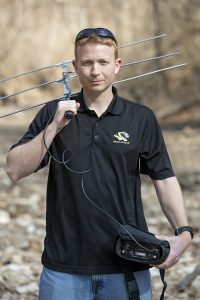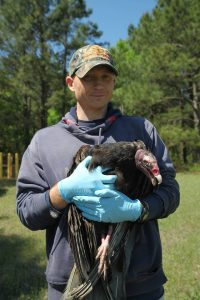Whether a creature has feathers, fur or fins, it really doesn’t matter to Mike Byrne. He just wants to know where it’s going and what it might do when it gets there.
Byrne is one of the newest faculty members in the College of Agriculture, Food and Natural Resources at the University of Missouri, arriving on campus in June 2017. The assistant professor of natural resources is an expert in the field of wildlife movement ecology. By learning more about why animals go where they go and do what they do, resource managers can improve conservation and species management efforts.
“I really have no taxonomic bias,” says Byrne of his interest tracking animals of all classes. “Some researchers identify themselves as the ‘deer guy’ or the ‘turkey guy,’ but not me. I’ll work with whatever species I can get my hands on.”

Byrne grew up on New York’s Long Island, on the doorstep of the nation’s largest metropolitan region. But it wasn’t the hustle and bustle of the big city that attracted the youngster. Instead, it was the sand and the seas, the beaches and barrier islands where he found himself enthralled with the natural world.
“I always liked being outside, fishing, just birdwatching, seeing critters and other nerdy things like that,” he says with a laugh. “I always wondered about the animals. You see an animal for five minutes out of its day or even its entire life. But what’s it doing the rest of the time? Where does it go? What does it do when you’re not looking?”
Byrne got his first taste of wildlife research while in high school, studying the piping plover, an endangered shorebird. He also worked at a local natural history museum, caring for animals in its collection.
After high school, Byrne attended Worcester State University in Massachusetts where he earned a bachelor’s degree in biology. He remained in New England to work on his master’s, earning the degree from the University of Rhode Island in Kingston. Byrne’s project focused on the nesting ecology of the northern harrier, a raptor species. However, he also began dabbling in animal movement research, helping with a shark-tracking project.
Byrne journeyed to Baton Rouge for his doctoral thesis at Louisiana State University, studying wild turkeys’ nesting ecology and raccoon habitat use and movement. The goal was to determine what, if any, impact raccoons had on the birds’ nesting success.
“We found out that down there and that time of the year when the turkeys are nesting, the raccoons don’t go anywhere near them,” Byrne says. “They just sit where they can shovel crawfish into their mouths, which is the exact opposite habitat from what the turkeys use.”
After receiving his doctorate, Byrne completed a series of postdoctoral fellowships before coming to Missouri. He studied wild turkeys in Georgia and vultures in South Carolina. He traveled to Belarus and studied the impacts of radiation from the Chernobyl nuclear accident on the distribution of mammals. And he tracked Atlantic Ocean shortfin mako sharks at the Guy Harvey Research Institute at Nova Southeastern University in Fort Lauderdale, Florida.
“We discovered the mako is being overfished like crazy,” Byrne says. “In 2017, I went to Spain as a U.S. scientific delegate to the International Commission for the Conservation of Atlantic Tunas, which is the governing body for fisheries management in the Atlantic Ocean. They assess shark populations, too, and found the same result we did. It was cool to have our research corroborated.”
With his diversified experience in animal tracking, it’s not surprising that the MU researcher currently has projects strewn across the animal kingdom in the Show-Me State — from grass carp at Truman Lake to prairie king snakes at Prairie Fork Conservation Area in Callaway County. He plans to begin projects with wild turkeys and perhaps carnivores such as bobcats and coyotes. He also intends to continue working with sharks, despite the geographic challenge it poses, and maybe even crocodiles in Costa Rica.
Byrne says the field of animal movement ecology has advanced rapidly during his career, which has created both opportunities and challenges related to technology. When he worked on his doctorate, for instance, he used wildlife VHF radio telemetry — a 1960s technology. Today, while Byrne still uses “old-school” methods, he also employs GPS and satellites to track animal movements on both land and sea.

“It wasn’t too long ago you could still get published just by showing that an animal was present someplace,” he says. “Now, it’s more than that. We know it’s there, but what’s it doing? There’s a lot of cool stuff you can learn when an animal tells you where it wants to go, what it likes to do, where it eats and even where it dies. Track a shark in the open ocean? No problem. You can really start asking questions you could never ask before.”
Of course, collecting so much information about individual animals can be a double-edged sword. Byrne says in some ways, the technology has developed faster than the analyses to handle it.
“In the old days, we’d complain, ‘We never have enough data to do anything with,’” he says. “Now it’s, ‘We have too much data to do anything with.’ So, it’s a blessing and a curse. I don’t have to physically track animals, so I can ask other questions, but it’s a matter of making sense of it all.”
Technological advancements also have allowed tracking apparatuses to become smaller and smaller, which allows researchers more opportunities for studying a wider range of animals. Some of today’s GPS transmitters weigh as little as 9 grams, or less than the weight of a single AAA battery.
“Getting that weight down is important, especially when studying birds,” Byrne says. Too much weight can negatively impact flight, reducing a bird’s effectiveness at hunting or evading predators, for instance. “There are even solar-powered trackers now, so battery life becomes less of an issue, and you can track for longer periods of time. We had one bird in my vulture research that we’ve tracked for more than six years.”
In addition to his research endeavors, Byrne also teaches graduate- and undergraduate-level courses, including ecosystem management and wildlife ecology methods. He intends to develop a graduate course on movement ecology in the future.
When he’s not tracking animals, Byrne enjoys putting a flyrod in his hand and tempting both salt and freshwater fish to take the bait. Though he hasn’t had an opportunity yet, he says he can’t wait to hook into the feisty smallmouth bass that swim in Missouri’s Ozark streams.
“I can’t believe I’ve almost been here a year already,” he says. “It doesn’t feel that long, but at the same time, it feels twice that long. I’m looking forward to exploring more of Missouri. I’m certainly in the right state for turkey research.”